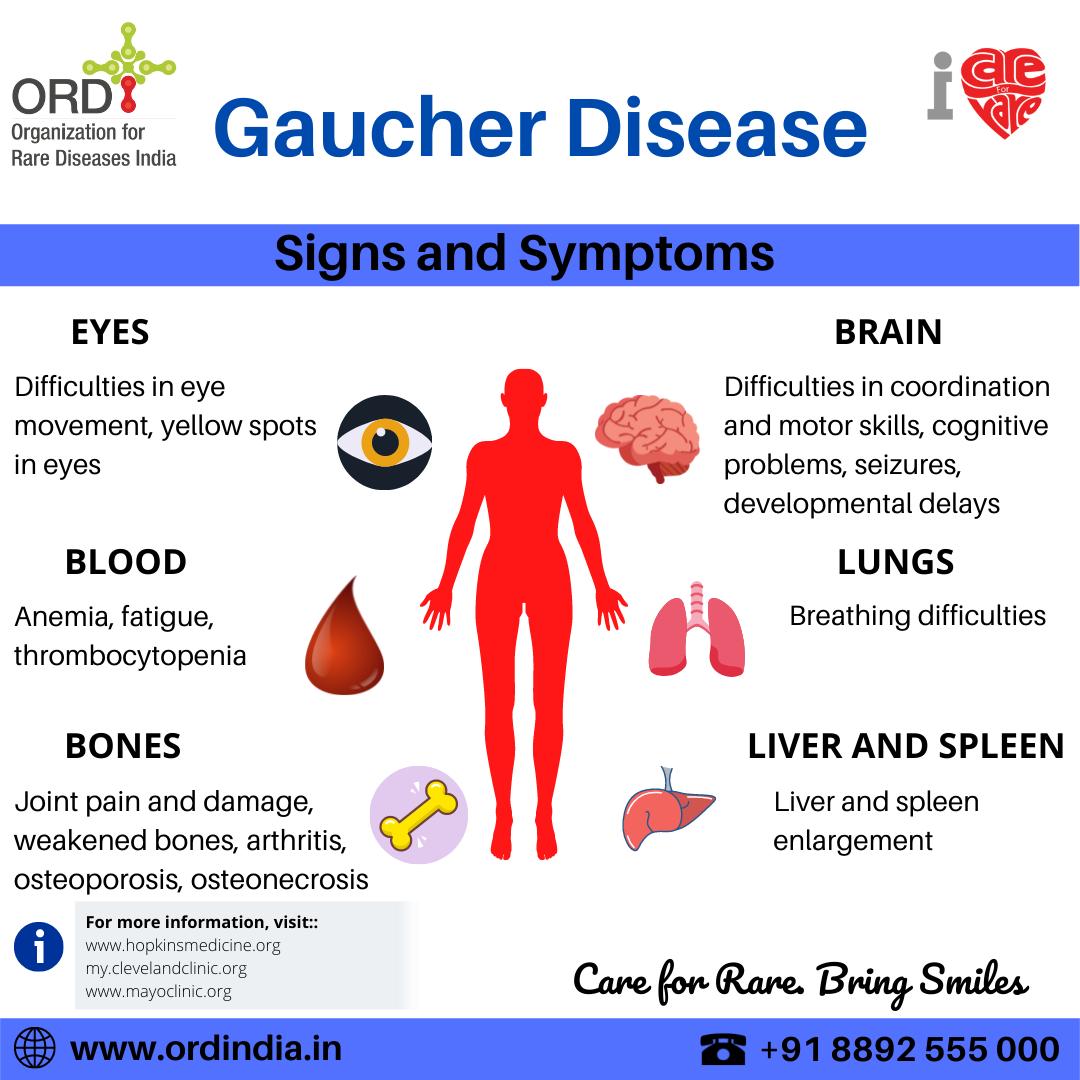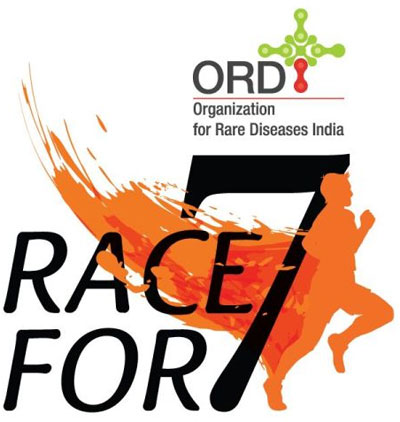Gaucher disease is a rare, inherited metabolic disorder occurring due to the storage of fatty substances, specifically -glycolipid glucocerebroside in organs like liver, spleen and bone marrow. This mainly occurs due to the deficiency of glucocerebrosidase enzyme and is listed under lysosomal storage disorder (LSD).
Figure 1: General symptoms of Gaucher disease
Symptoms vary across each individual and also differ according to the type of Gaucher disease. Some have mild or no sign of symptoms.
Common signs and symptoms are:
- Weakening of bones leading to bone fractures and bone pain.
- Arthritis, osteoporosis and osteonecrosis.
- Anemia (low number of red blood cells), leading to fatigue
- Thrombocytopenia (low level of platelets) leading to easy bruising and bleeding of nose.
- Enlargement of liver and spleen (hepatosplenomegaly) due to accumulation of fatty chemicals.
Types:
- Type 1: most common occurrence and affects liver, spleen, bones and blood. Occurs from childhood to adulthood.
Common symptoms – chronic fatigue caused due to low RBC count(anemia), easy bruising and bleeding caused by low platelet count (thrombocytopenia) and enlargement of spleen and liver. Lack of blood supply to bones leading to bone pain, deformity and degeneration of bones, weakening of bones.
- Type 2: known as Acute neuronopathic Gaucher disease, affects the brain leading to neurological complications. Occurs in new-born babies.
Common symptoms – Spleen enlargement, severe damage in brain leading to difficulties in motor skills, low muscle tone, involuntary muscle spasms, crossed eyes, feeding difficulties.
- Type 3: known as Chronic neuronopathic Gaucher disease. Occurs in kids under the age of 10 years.
Common symptoms – brain issues, bone, lung disease and other organ problems.
Cause:
Gaucher disease is inherited in an autosomal recessive form and is caused due to changes in the GBA (glucosyl ceramidase beta) gene, coding for glucocerebrosidase enzyme, located on chromosome 1.
Patients with Gaucher disease lack/ do not have sufficient amount of glucocerebrosidase enzyme which plays a major role in the breakdown of sphingolipids. This leads to accumulation of the glucocerebroside enzyme in tissue macrophages, immune cells, hepatocytes and osteoblasts.
Affected population:
Gaucher disease is seen to affect males and females equally and the most frequently occurring is the Gaucher disease Type 1. Its occurrence is 1:50000 in general population
High incidence of this disease is observed in Ashkenazi Jews, with occurrence of 1 out of every 450 births and 1 in 4 individuals is a carrier.
Diagnosis:
Clinical evaluation in patients performed to check for the disease
- Enzyme Assay– BGL (beta – glucosidase leukocyte) blood test– check for the level of beta – glucosidase in skin cells, white blood cells.
- Further genetic analysis -performed using blood or saliva to check for mutations.
- Prenatal diagnosis – amniocentesis or chorionic villus sampling– performed to confirm the presence of disease.
- Imaging tests – MRI test– to check if there is enlargement in liver or spleen and the condition of bone marrow. Dual energy X-ray absorptiometry– used to measure bone density.
Treatment:
No permanent cure for Gaucher disease, however various treatment options available to control symptoms.
- Enzyme replacement therapy – replaces the deficiency of the glucose cerebrosidase enzyme with artificial enzymes. It involves intravenous infusions every 2 weeks.
- Substrate reduction therapy – reduce the glucocerebroside level in the body.
- Osteoporosis drugs – taken for strengthening and rebuilding bones.
- Miglustat and Eliglustat – interfere with the production of fatty chemicals and inhibit more production of them.
- Removal of spleen before enzyme replacement therapy is performed at times. Bone marrow transplant is another surgical procedure performed as a treatment for Gaucher disease.
Other names of this condition:
- Gaucher splenomegaly
- Cerebroside lipidosis syndrome
- Glucocerebrosidase deficiency
- Glucocerebrosidosis
- Glucosyl cerebroside lipidosis
- Kerasin lipoidosis
- Kerasin thesaurismosis
- Lipid histiocytosis
- Sphingolipidosis 1
- Glucosylceramidase deficiency
We appreciate the efforts of Ms. Panchami.P, MSc. BMG, VIT, Vellore in curating the content for Gaucher disease.
References:
- https://rarediseases.org/rare-diseases/gaucher-disease/
- https://www.genome.gov/Genetic-Disorders/Gaucher-Disease
- https://www.mayoclinic.org/diseases-conditions/gauchers-disease/symptoms-causes/syc-20355546
- https://www.gaucherdisease.org/about-gaucher-disease/
- https://www.hopkinsmedicine.org/health/conditions-and-diseases/gaucher-disease
- https://my.clevelandclinic.org/health/diseases/16234-gaucher-disease
- Sheth, J., Bhavsar, R., Mistri, M. et al.Gaucher disease: single gene molecular characterization of one-hundred Indian patients reveals novel variants and the most prevalent mutation. BMC Med Genet 20, 31 (2019).
Last updated: 19th August 2021





